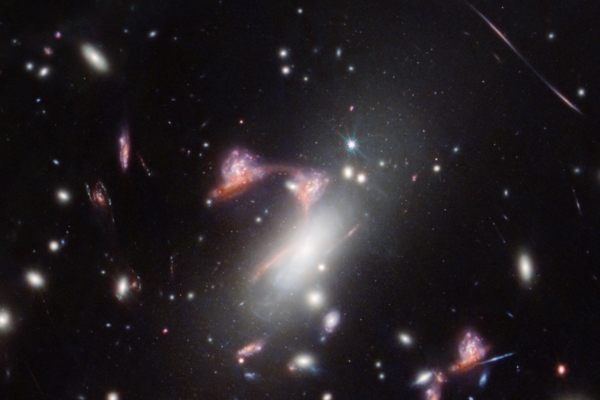In recent times, as time passes, many previously unseen magical wonders of celestial bodies are emerging before people. Most recently, Canadian astronomers have discovered a peculiar structure resembling a “red giant question mark” through the lenses of NASA’s space telescopes, as if a fascinating puzzle deliberately left by the heavens for humankind.
The Goddard Space Flight Center of NASA utilized the Hubble (HST) and James Webb’s (JWST) space telescopes to observe a galaxy cluster, revealing an intriguing “red giant question mark (QMP)” through near-infrared imaging and the Near Infrared Imager and Slitless Spectrograph (NIRISS).
Initially, scientists observed the MACS-J0417.5-1154 galaxy cluster through the Hubble Space Telescope and found that the mass of the cluster was so immense that it caused significant spatiotemporal distortion, resulting in a strong arc-like smearing appearance of galaxies in that region in the universe. This phenomenon is referred to as the “gravitational lensing effect” by scientists.
This distortion allows astronomers to see galaxies behind the star cluster and more related details through the telescope. Scientists opted to use the James Webb Space Telescope to detect longer wavelength (infrared light) capabilities to observe the MACS-J0417.5-1154 galaxy cluster.
By analyzing five galaxy lens images captured by the James Webb Space Telescope, scientists observed the surroundings of the MACS-J0417.5-1154 galaxy cluster. After a series of systematic analysis and comparison with previous data acquired by Hubble, they discovered an intriguing red galaxy dust in the shape of a “big question mark (QMP).”
In the four images taken by the James Webb Space Telescope, the main body of the “red giant question mark (QMP)” is composed of several galaxies. One galaxy is an edge-on galaxy heavily obscured by dust, while another is a face-on galaxy formed by stars linked in clusters on a disk-like system.
Scientists state that the “red giant question mark” is primarily composed of a “main body” and a “point” below it. Viewing the “main body” from Earth’s perspective, it consists of the GR150R and GR150C galaxy groups, rather than the initially identified 3 galaxy groups, as the galaxies below the main body were found to be a result of light signal contamination after exclusion.
These galaxies are amplified by their respective gravity, causing spatial and shape distortions. One blue face-on galaxy is formed by a disk and several clumps of star clusters region, alongside a highly dust-obscured red edge-on galaxy.
Furthermore, the “point” in this question mark is composed of unrelated galaxies that happen to be in that position, forming a complete “red giant question mark.” Scientists suggest that this implies the need for distant galaxies, gravitational lensing effects, and special, rare interactions between galaxies to manifest.
Within the “red giant question mark,” scientists have identified a total of 20 clusters. Seven clusters are undergoing explosive star formation; 10 clusters have lower masses and may be in a destructive phase, while 3 clusters are in equilibrium (either in stable star formation state or post-explosive state).
Moreover, they found that the main region of the blue face-on galaxy is currently likely in a phase of destruction, equilibrium, or low equilibrium.
One of the main researchers of the team, Marcin Sawicki, an astronomer at Saint Mary’s University in Canada, told NASA, “The Webb telescope seeing these galaxies might be how these stars looked billions of years ago, with their mass at that time possibly similar to that of the past Milky Way. We are studying what the Milky Way might have looked like in its adolescent phase through these findings.”
Vicente Estrada-Carpenter, an astronomer at Saint Mary’s University, stated, “Understanding the timing, location, and manner of star formation within galaxies is crucial for understanding how galaxies evolved throughout cosmic history. Spectral data also confirms that the newly discovered dusty galaxy is at a similar distance to the face-on spiral galaxy, suggesting they are likely to interact.”
He continued, “The two galaxies within this cosmic question mark both exhibit active star formation in multiple dense regions, implying the results of gas collisions between the two galaxies. Currently, the shapes of the two galaxies do not appear too disrupted, indicating that they have just begun to interact.”
Guillaume Desprez, an astronomer from Sao Paulo, stated, “To date, we have only observed three to four cases related to the gravitational lensing effect. This astronomical discovery not only demonstrates the capabilities of the Webb telescope but also indicates that more events related to the gravitational lensing effect will be discovered in the future.”

